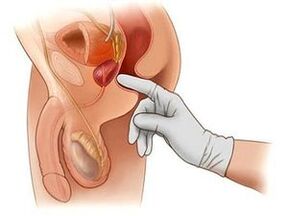Currently, the question of how to diagnose prostatitis is of concern to more than half of men. Now we are talking about members of the stronger sex aged 30-35 years, but this figure is declining, young people may also suffer from this disease. At the first signs it is necessary to contact a urologist and undergo treatment. That's why it's important to know how to recognize prostatitis yourself.
Signs of acute form
In the case of the acute form, it is quite easy to understand how to identify prostatitis in men. In fact, it is an inflammatory process that is caused by complications after the common cold. This may be hypothermia, SARS or acute respiratory infections. It is a viral, fungal or bacterial infection that accidentally enters the prostate gland.

In this case, there are several symptoms of prostatitis - and how to determine it is easy for everyone to understand:
- The temperature is over 38 degrees.
- Nausea and vomiting due to intoxication.
- Thrill and weakness.
- Muscle pain.
- Discomfort in the lower abdomen.
- Pain when urinating.
- A small amount of blood in the urine.
- Sexual dysfunction.
In this situation you should contact a specialist immediately. The main feature of the acute form is that it heals quickly and easily. After undergoing treatment and recovery, a man can be sure that he will get rid of all symptoms, including normalization of sexual function.
Symptoms of chronic disease
The chronic form is a little more dangerous. In this case the symptoms are more stable, long-term complex treatment is needed. Often, even after that, relapses can occur. It is necessary to consult a doctor as soon as possible, only at an early stage there is hope for recovery. Symptoms include the following:
- The temperature rises to 37 degrees. This happens periodically, not continuously.
- Often a desire for a toilet. At the same time, urination is disturbed, the flow is very weak.
- Symptom of pain. Unpleasant sensations can be given to the sacrum and scrotum.
- Erectile dysfunction, sex life is significantly impaired.
All these symptoms greatly embarrass any member of the stronger sex. That is why it is important to know in advance how to find out that you have prostatitis and take action.
Unlike other diseases
It is difficult to learn about the disease yourself. The symptoms may be similar for different diagnoses. Men suffer from urogenital problems for several reasons. These can be common diseases:
- Orchitis and epididymitis cause testicular irritation. As a result, there may be similar signs, and there will be sharp pain when touching the scrotum.
- Urethritis is accompanied by acute pain in the urethra, sometimes giving way to the abdomen in case of complications.
- Cystitis is accompanied by a constant desire for toilet and is often associated with urethritis.
- Pyelonephritis means kidney problems, there will be back pain, and the presence of blood in the urine.
Many of the symptoms are really very similar. Therefore, prostatitis should be determined exclusively by a professional. The specialist will conduct a full examination and select individual treatment.
Professional diagnostics
Given that the symptoms can be similar to many other diagnoses, if any symptoms appear, you should consult a doctor and not self-medicate. The doctor should perform a thorough examination:
- Rectal palpation. Through the colon, the doctor will be able to feel the prostate and assess its condition and size.
- cytology. A sample of prostate secretion is sent to a laboratory and tested for various bacteria and infections.
- Urine analysis. Don't forget to do it in a special way. For one trip to the toilet, three glasses are filled: at the beginning, at the end and in the middle of urination.
- Prostate ultrasound is performed rectally, it can be used to examine the prostate and the area around it on the device.
- Rheography is performed with the help of electrodes, the reaction of the prostate gland to irritation is measured.
- Uroflowmetry checks for urine problems. This applies to the speed, duration and periods between trips to the toilet.
Most men postpone a visit to the doctor until the last stage. True, the examination is not very pleasant and disturbing, but it is necessary to maintain health.
Often in the chronic advanced stage, even a specialist can not help solve problems, the symptoms do not disappear completely. It would be better to see a doctor once, get tested and cured than to suffer from erectile dysfunction and urinary problems throughout your life.





























